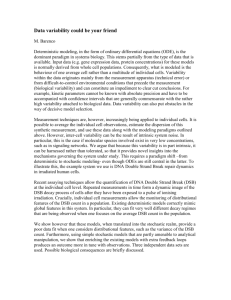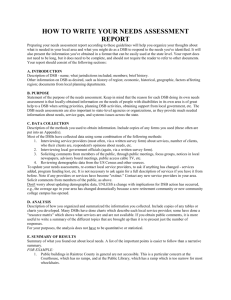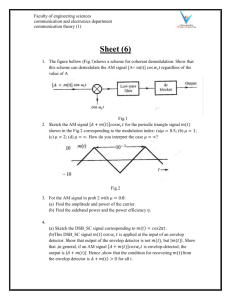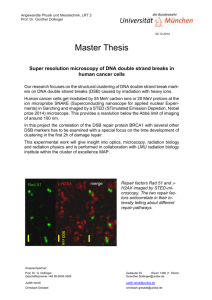Volume 6, 2002 1 T. Meunargia I. Vekua Institute of Applied Mathematics
advertisement
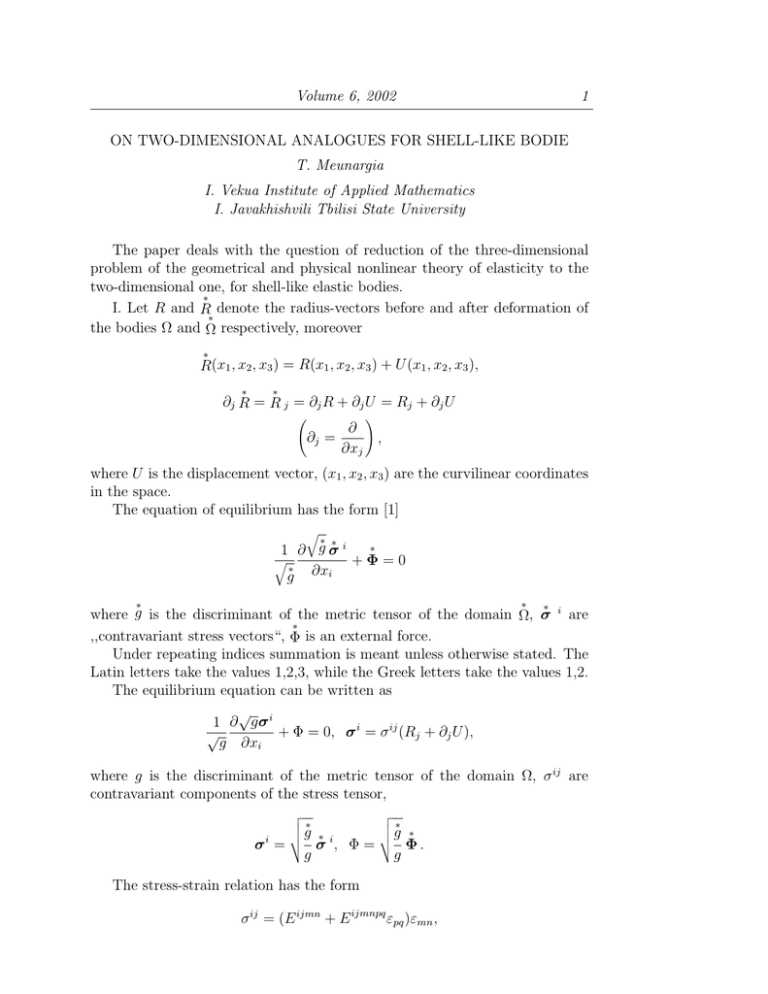
Volume 6, 2002 1 ON TWO-DIMENSIONAL ANALOGUES FOR SHELL-LIKE BODIE T. Meunargia I. Vekua Institute of Applied Mathematics I. Javakhishvili Tbilisi State University The paper deals with the question of reduction of the three-dimensional problem of the geometrical and physical nonlinear theory of elasticity to the two-dimensional one, for shell-like elastic bodies. ∗ I. Let R and R denote the radius-vectors before and after deformation of ∗ the bodies Ω and Ω respectively, moreover ∗ R(x1 , x2 , x3 ) = R(x1 , x2 , x3 ) + U (x1 , x2 , x3 ), ∗ ∗ ∂j R = R j = ∂j R + ∂j U = Rj + ∂j U ∂ ∂j = ∂xj ! , where U is the displacement vector, (x1 , x2 , x3 ) are the curvilinear coordinates in the space. The equation of equilibrium has the form [1] q ∗ ∗ ∗ 1 ∂ gσi q + Φ =0 ∗ g ∂xi ∗ ∗ ∗ where g is the discriminant of the metric tensor of the domain Ω, σ i are ∗ ,,contravariant stress vectors“, Φ is an external force. Under repeating indices summation is meant unless otherwise stated. The Latin letters take the values 1,2,3, while the Greek letters take the values 1,2. The equilibrium equation can be written as √ 1 ∂ gσ i + Φ = 0, σ i = σ ij (Rj + ∂j U ), √ g ∂xi where g is the discriminant of the metric tensor of the domain Ω, σ ij are contravariant components of the stress tensor, σi = v u∗ ug t ∗ i σ , g Φ= v u∗ u tg ∗ g Φ. The stress-strain relation has the form σ ij = (E ijmn + E ijmnpq εpq )εmn , 2 Bulletin of TICMI where E ijmn and E ijmnpq are tensors of elasticity of the fourth and sixth rank, respectively, εij are covariant components of the strain tensor, moreover E ijmn = λg ij g mn + µ(g im g jn + g in g jm ), E ijmnpq = η1 g ij g mn g pq + η2 g ij (g mp g nq + g mq g np )+ +η3 g mn (g ip g jq + g iq g jp ) + η4 g pq (g im g jn + g in g jm ), 1 εmn = (Rm ∂n U + Rn ∂m U + ∂m U ∂n U ), 2 λ and µ are Lame’s constants of elasticity, and η1 , η2 , η3 , η4 are modules of elasticity of the second order for isotropic elastic bodies, g ij = Ri Rj are contravariant components of the metric tensor, Ri and Ri are co and contravariant base vectors. II. 1. We consider the coordinate system of lines of curvature, which is connected normally to the midsurface S of the shell Ω, i.e. R(x1 , x2 , x3 ) = r(x1 , x2 ) + x3 n(x1 , x2 ), where r and n are radius-vectors and a normal of the S, x3 is the thickness coordinate −h ≤ x3 ≤ h, h = const is the semi-thickness. The dependence between covariant and contravariant base vectors of the shell Ω and the midsurface S, are expressed as follows Rα = (1 − kα x3 )rα , Rα = rα , R3 = R3 = n, (α = 1, 2) 1 − kα x3 (on α no summation!) where k1 and k2 are main curvatures of the midsurface S, i.e. Ri = (1 − ki x3 )ri , Ri = √ g= ri aij , g ij = , 1 − ki x3 (1 − ki x3 )(1 − kj x3 ) √ a(1 − k1 x3 )(1 − k2 x3 ), a = a11 a22 − a212 , aαβ , i = α, j = β; a = r r = 0, i = 3, j = β, or i = α, j = 3; 1, i = j = 3, ij i j aαβ = rα rβ , aα3 = a3β = 0, a33 = 0, k3 = 0 (on i, j, α, β no summation!). For the tensor εij we obtain ! 1 ∂j U ∂i U ∂j U ∂i U + ri + , εij = (1 − ki x3 )(1 − kj x3 ) rj 2 1 − ki x3 1 − kj x3 1 − ki x3 1 − kj x3 Volume 6, 2002 3 (on i, j no summation!) i.e. ∂β U ∂α U ∂α U ∂β U 1 + rα + )= εαβ = (1 − kα x3 )(1 − kβ x3 )(rβ 2 1 − kα x3 1 − kβ x3 1 − kα x3 1 − kβ x3 = (1 − kα x3 )(1 − kβ x3 )eαβ , 1 ∂α U ∂α U εα3 = (1 − kα x3 )(n + rα ∂3 U + ∂3 U )= 2 1 − kα x3 1 − kα x3 = (1 − kα x3 )eα3 , 1 ε33 = n∂3 U + (∂3 U )2 = e33 . 2 2. Now, we assume the validity of the representations: ∂1 U = (1 − k1 x3 )∂1 V (x1 , x2 ), ∂2 U = (1 − k2 x3 )∂2 V (x1 , x2 ), ∂3 U = Vb (x1 , x2 ), where V and Vb are the two-dimensional vectors of x1 , x2 . Taking into consideration the condition ∂1 ∂2 U = ∂2 ∂1 U ⇒ ∂2 (k1 ∂1 V ) = ∂1 (k2 ∂2 V ), ∂3 ∂1 U = ∂1 ∂3 U ⇒ ∂1 Vb = −k1 ∂1 V, ∂3 ∂2 U = ∂2 ∂3 U ⇒ ∂2 Vb = −k2 ∂2 V, for V (x1 , x2 ) we obtain the following equation (k1 − k2 ) ∂k1 ∂V ∂k2 ∂V ∂ 2V + − = 0. ∂x1 ∂x2 ∂x2 ∂x1 ∂x1 ∂x2 Now, from the system of Gauss equations √ ∂ ln a11 ∂k1 = (k2 − k1 ) , ∂x2 ∂x2 √ ∂ ln a22 ∂k2 = (k1 − k2 ) , ∂x1 ∂x1 we have " # √ √ ∂ ln a11 ∂V ∂ ln a22 ∂V ∂2V (k1 − k2 ) − − = 0. ∂x1 ∂x2 ∂x2 ∂x1 ∂x1 ∂x2 The general solution of this equation has the form [2] Zx1 x2 Z ∂R(x01 , t, x1 , x2 ) ∂R(t, x02 , x1 , x2 ) dt− v(τ ) dτ. V (x1 , x2 ) = u(x1 )+v(x2 )− u(t) ∂t ∂τ 0 0 x1 x2 4 Bulletin of TICMI where R(t, τ, x1 , x2 ) is a Riemann function, u(x1 ) and v(x2 ) are arbitrary vectors. For the vector U (x1 , x2 , x3 ) we obtain U (x1 , x2 , x3 ) = Zx2 ∂V (x1 , x2 ) dx1 + ∂x1 Zx2 ∂V (x01 , x2 ) dx2 + ∂x2 x01 + x20 [1 − x3 k1 (x1 , x2 )] [1 − x3 k2 (x01 , x2 )] + (x3 − x03 )Vb (x01 , x02 ) + U (x01 , x02 , x03 ), and Vb =− Zx1 x01 ∂V dx2 − k1 (x1 , x2 ) ∂x1 Zx2 x02 k2 (x01 , x2 ) ∂V (x01 , x2 ) dx2 + Vb (x01 , x02 ). ∂x2 Now for emn we have the following two-dimensional expressions: 1 eαβ = (rα ∂β V + rβ ∂α V + ∂α V ∂β V ), 2 1 eα3 = (n∂α V + rα V Vb + Vb ∂α V ), 2 1 e33 = nVb + Vb 2 . 2 i The ,,contravariant stress vector“ σ has the form σ i = (1 − kj x3 )σ ij (rj + ∂j v) = Ti 1 − ki x3 (on i no summation!), where T i = (M ijmn + M ijmnpq epq )emn (rj + ∂j V ), ∂j V = Here ( ∂α V, j = α, Vb , j = 3. M ijmn = λaij amn + µ(aim ajn + ain ajm ) M ijmnpq = η1 aij amn apq + η2 aij (apm anq + amq anp )+ +η3 amn (aip ajq + aiq ajp ) + η4 apq (aim ajn + ain ajm ). At last, we obtain the following two-dimensional equation of equilibrium: √ ! √ 1 ∂ a(1 − k2 x3 )T 1 ∂ a(1 − k1 x3 )T 2 √ + + a ∂x1 ∂x2 Volume 6, 2002 + 5 ∂(1 − k1 x3 )(1 − k2 x3 ) 3 T + (1 − k1 x3 )(1 − k2 x3 )Φ = 0, ∂x3 where T α = (M αβmn + M αβmnpq epq )emn (rβ + ∂β V )+ +(M α3mn + M α3mnpq epq )emn (n + Vb ), T 3 = (M 3βmn + M 3βmnpq epq )emn (rβ + ∂β V )+ +(M 33mn + M 33mnpq epq )emn (n + Vb ). 3. Let us consider the boundary condition for the stresses. ∗ The stress vector σ ∗ acting onto area with the mormal (l) has the form l σ ∗ ∗ ∗ ∗ ∗ = σ i l i (l i = l R i ). ∗ (l) ∗ The normal l after deformation can be defined as ∗ s ∗ l= ∗ ∗ |s ∗ ×s 1 1 2 ∗ × s 2| , ∗ ∗ where s 1 and s 2 are unit tangent vectors of the boundary surface ∂ Ω ,with the surface element ∗ ∗ ∗ ∗ ∗ d S = | s 1 × s 2 |d s 1 s 2 . Then we have 1 ∗ l= ∗ |s ∗ × s 2| 1 ∗ dR ∗ ds 1 ∗ × dR = ∗ ∗ ds 2 |s dxi dxj ds1 ds2 =Ri×Rj = ds1 ds2 d S∗ ∗ = v u∗ ug √ t = g v u∗ ug t g ∗ ∗ g ∈ijk R k dxi dxj ds1 ds2 = ds1 ds2 d S∗ ∗ (s1 × s2 )Rk R k ds1 ds2 ∗ dS ∗ ⇒l= ∗ ∗ ∗ g 1 q ∗ × s 2| ∗ ∗ g ∈ijk R k v u∗ u tg g ∗ ∗ d R d R ds1 ds2 = × ds1 ds2 d s∗ 1 d s∗ 2 dxi dxj ds1 ds2 = ds1 ds2 d S∗ ∗ (Ri × Rj )Rk R k v u∗ u tg dxi dxj ds1 ds2 = ds1 ds2 d S∗ ∗ |s1 × s2 |ds1 ds2 s1 × s2 ⇒ Rk R k ∗ g |s1 × s2 | dS = v u∗ u tg 1 ∗ (lRk ) R k ⇒ li = lRi = v u∗ u tg li dS g d S∗ dS ∗ dS ⇒ (li = lRi ), 6 Bulletin of TICMI s1 × s2 is the normal of the boundary surface before deformation, |s1 × s2 | dS is the element of this surface, where l = dS = |s1 × s2 |ds1 ds2 , ∈ijk are the Levi-Civita symbols. Now the strees vector can be written as ∗ ∗ ∗ σ∗ =σli = (l) i.e., v u∗ ug ∗ t σil g i dS ∗ dS = σ i li dS ∗ , dS ∗ dS σ∗ = σ i li = σ α lα + σ 3 l 3 , ( l ) dS ∗ where lα = lRα , l3 = ln. On the surfaces x3 = ±h we have l = n and so σ (n) (x1 , x2 , ±h) = σ 3 (x1 , x2 , ±h). The stress vector σ normal lb has the form ∗ (l) acting on the lateral surface dSb = dsbdx3 with the b ). σ (bl) = σ α (lR α The normal lb before deformation can be defined as: where lb = dR × n, dsb dR ds dn dR d(r + x3 n) ds = sb = = = s + x3 dsb ds dsb ds dsb ds Therefore, ⇒ sb = [(1 − k3 x3 )s + τs x3 l] ds . dsb ds , dsb (lb × sb = n, l × s = n). lb = [(1 − k3 ks )l − x3 τs s] ! ds ⇒ dsb b sb and l, s are the unit vectors of the tangential normal and tangent where l, of the lateral curve of the surfaces x3 = const and x3 = 0 (midsurface), respectively, ks and τs are the normal curvature and geodesic torsion of the midsurface, dsb and ds are linear elements of the surfaces x3 = const and x3 = 0, respectively, moreover dsb = q 1 − 2x3 ks + x32 (ks2 + τs2 )ds ⇒ Volume 6, 2002 ⇒ dsb = v u u t a11 (1 − k1 x3 )2 dx1 ds !2 + a22 (1 − k2 x3 7 )2 dx2 ds !2 ds. On the other hand, we have [3] lb = dxα ds √ dR dR ds dxα ds ×n= × n = Rα × n = g ∈α3β Rβ = dsb ds dsb ds dsb ds dsb = Therefore, r r g√ g dxα ds dxα ds a ∈α3β Rβ (rα × n)rβ Rβ = = a ds dsb a ds dsb r r g g ds β ds = ⇒ = (s × n)rβ R (lrβ )Rβ a dsb a dsb r g ds b b ⇒ lRβ = lβ = lβ . a dsb σ (bl) = σ α lbα = r g α ds σ lα ⇒ a dsb ds = (1 − k1 x3 )(1 − k2 x3 )(σ 1 l1 + σ 2 l2 ) ⇒ dsb ds σ (bl) = (1 − k2 x3 )T 1 l1 + (1 − k1 x3 )T 2 l2 . dsb Thus, we obtain the following system of two-dimensional equations of the geometrically and physically non-linear theory for shell-like elastic bodies: a) Equilibrium equations √ ! √ 1 ∂ a(1 − k2 x3 )T 1 ∂ a(1 − k1 x3 )T 1 √ + − 2(H − Kx3 )T 3 + F = 0 a ∂x1 ∂x2 ⇒ σ (bl) (0) 2H = k1 + k2 , K = k1 k2 , (1 − k1 x3 )(1 − k2 x3 )Φ = F = F +x3 F b) Stress-strain relation T i (x1 , x2 ) = (M iβmn + M iβmnpq epq )emn (rβ + ∂β V )+ where III. Special cases +(M i3mn + M i3mnpq epq )emn (n + Vb ), 1 eαβ = (rα ∂β V + rβ ∂α V + ∂α V ∂β V ), 2 1 eα3 = (n∂α V + nVb + Vb ∂α V ), 2 1 e33 = nVb + Vb 2 . 2 ! (1) ; 8 Bulletin of TICMI 1 1. Spherical shell (k1 = k2 = − ) R The vector of displacement U for the spherical shell has the form U (x1 , x2 , x3 ) = 1 + x3 V (x1 , x2 ) ⇒ R x3 ∂α U = 1 + ∂α V (α = 1, 2), R ⇒ ∂ U = 1 V. 3 R The equation of equilibrium can be written as: √ 1 ∂ aT α 2 √ + T 3 + F = 0, a ∂xα R where T i (x1 , x2 ) = (M ijmn + M ijmnpq epq )emn (rj + ∂j V ) (∂3 V = 1 V ), R 1 emn (x1 , x2 ) = (rm ∂n V + rn ∂m V + ∂m V ∂n V ), 2 x3 Φ. F (x1 , x2 ) = 1 + R The stress vector has the form σ (l) x3 ds = 1+ T α lα = T α lα = T(l) , R dsb x3 ds . dsb = 1 + R 2. Cylindrical shell (k1 = − R1 , k2 = 0) The vector of displacement for the cylindrical shell has the form x3 U (x1 , x2 , x3 ) = 1 + u(x1 ) + v(x2 ). R Then x3 du(x1 ) ∂1 v = 1 + R dx1 dv(x2 ) ∂2 v = dx 2 1 ∂3 v = u(x1 ) R The equilibrium equation looks like: √ 1 ∂ aT 1 1 √ + T 3 = 0, a ∂x1 R Volume 6, 2002 9 √ 1 ∂ aT 2 √ + Φ = 0 (Φ = Φ(x1 , x2 )), a ∂x2 where i T = (M +(M i1mn i2mn +M +M i1mnpq i2mnpq du(x1 ) r1 + dx1 epq )emn epq )emn ! ! 1 u(x1 ) . R dv(x2 ) r2 + dx2 +(M i3mn + M i3mnpq epq )emn n + Here M ijmn = λδ ij δ mn + µ(δ im δ jn + δ in δ jm ), M ijmnpq = η1 δ ij δ mn δ pq + η2 δ ij (δ mn δ nq + δ mn δ np )+ +η3 δ mn (δ ip δ jq + δ iq δ jp ) + η4 δ pq (δ im δ jn + δ in δ jm ), ij δ = For the eij we obtain e12 e11 ( 1, i = j 0, i = 6 j ! . du(x1 ) du dv dv(x2 ) 1 r1 = + r2 + 2 dx1 dx2 dx1 dx2 du 1 = r1 + dx1 2 ! ! ! e13 r1 u u du 1 du n + + = , 2 dx1 R R dx1 e23 dv r2 u 1 u dv = n + + , 2 dx2 R R dx2 du dx1 !2 , e22 dv 1 + = r2 dx2 2 dv dx2 !2 = e21 , , e33 = nu u2 . + R 2R2 The stress vector σ (bl) has the form (lb = r2 ): σ (bl) = σ (r2 ) = (1 + x3 2 ds )T l2 = T 2 . R dsb REFERENCES [1] Vekua I.N., Shell Theory: General Methods of Construction. Moscow, Nauka, 1982 (Russian) [2] Vekua I.N., New Methods of Solution of Elliptic Equations. Moscow, Gostekhizdat, 1948 (Russian) [3] Meunargia T.V., On The Method of Geometrically Nonlinear Theory of Non-Shallow Shells. Proceedings of A.Razmadze Mathematical Institute, vol.119, 1998 Received June 21, 2002; revised October 20, 2002; accepted December 5, 2002.

